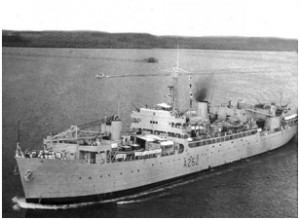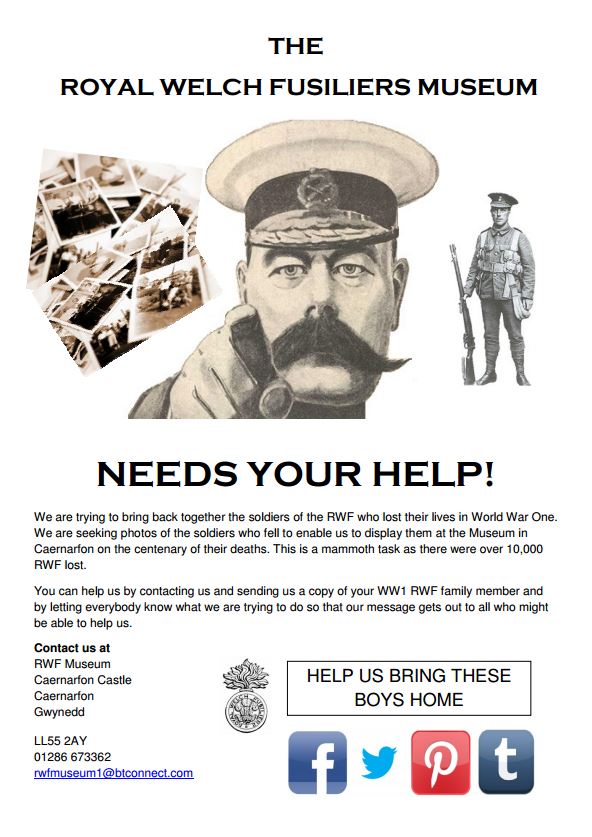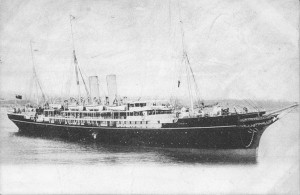Personal account of Republican internees escape from HMS Maidstone on 17 Jan 1972
History Hub Ulster recently interviewed Tom, a former Royal Navy Stoker from Bangor, who served on HMS Hartland Point in the early 1970s. Here’s his account:

HMS Hartland Point
“The Hartland Point was brought to Belfast and originally moored ahead of the Maidstone. Before Harland Point’s arrival, prisoners, sailors and prison officers were all accommodated on the Maidstone which was not ideal. In 1972 the decision was taken to move Hartland Point around to the stern of Maidstone. Maidstone was to have her stern cut open, and Hartland Point her bow, to enable a gangway to be connected between the two. This would afford the prison officers quick access on to the Maidstone when required.”
“As an electrical engineer, my duties were mainly maintenance. Prisoners bunk lights would often fail. When they reported it, it was my job to fix it. I would be escorted by a prison officer onto the Maidstone and in to the prisoners’ accommodation. It was quite scary at times!”
Tom was serving on board Hartland Point on 17th January 1972 when seven Republican prisoners escaped:
“Hartland Point had mooring cables connected from her stern to the bows of Maidstone. When she was moved, the cables on Maidstone’s bows were left dangling. Prisoners spotted the cables dangling outside the scuttles (portholes) and saw the opportunity to escape. During the night, they managed to pull the ropes in to the scuttles and climb out on to them. They used the ropes to swing themselves out to a point where they could get through the barbed wire, and descended into the icy cold water to make their escape.”
These men were referred to as ‘The Magnificent Seven’. Their side of the story can be found at http://www.anphoblacht.com/contents/16314 (copied below):

HMS Maidstone in Belfast
The Magnificent Seven
BY ARAN FOLEY
This week 35 years ago, on 17 January 1972, seven republican internees escaped from the British prison ship, HMS Maidstone, moored at the coal wharf in Belfast docks, and swam to freedom. They achieved fame in news headlines across the world as ‘The Magnificent Seven’.
Originally a Royal Navy submarine depot ship, the Maidstone was used as an emergency billet for British troops. After the introduction of internment, though, of the original 226 people detained, 122 were held in the Maidstone in the most cramped and inhumane of conditions where opportunities for even the most basic of needs such as exercise were virtually non-existent. Gerry Adams was held there for a brief time.
Some of the internees had been planning an escape and the transfer of 50 internees to the new internment camp at Magilligan the day before meant they had to urgently push forward their plan.
The men — Jim Bryson, Tommy Tolan, Thomas Kane, Martin Taylor, Tommy Gorman, Peter Rodgers and Seán Convery — had noticed a seal swimming through the ring of barbed wire which surrounded the ship. The prisoners reasoned that the gap was also sufficient to allow a human through. They had also been tossing tin cans overboard to monitor the movements of the tide.
On the night of 16 January, the conditions were judged right and the escape bid was ready to go. The nervous tension was exacerbated by a late head-count of internees by guards, causing an unexpected delay of 20 minutes which was to almost scupper the escape’s success. The head-count over, the escape went ahead behind schedule.
In a scene reminiscent of a Second World War POW movie, the men camouflaged themselves with boot polish and covered themselves in butter to insulate themselves from the cold waters they would have to swim through if they were to make it to freedom. Cutting through a steel bar in a porthole, they clambered down the ship’s steel cable.
It took them 20 minutes to swim through the bitingly cold water. Several of the men who couldn’t swim had to be helped by their comrades. Despite this, and serious injuries inflicted by the barbed wire, all seven men made it ashore otherwise unscathed. The problem was that they had landed 500 yards down from the agreed rendezvous point with units of the IRA’s Belfast Brigade, waiting to take them to safe houses.
By the time the escapees had made it to the original meeting point, their comrades had left, believing that the non-appearance of the Maidstone men meant that the escape had been aborted.
This forced the escapees, cold and dripping wet, to improvise.
They commandeered a bus at Queens Road Terminus and drove across the city themselves. Peter Rodgers (clad only in his underpants!) approached a bus driver and asked him for a loan of his overcoat, explaining to the somewhat startled driver, and in something approaching the truth, that he had fallen in to the water. The driver handed over his coat and then set off on his route. On his return at 6.30pm he left the bus. The seven men clambered aboard. Rodgers, who had been a bus driver himself, took the wheel and off they sped. Reaction from the security men at the main gate was minimal, which is probably explainable by the fact that it was not every day they were confronted by the spectacle of a bus full of semi-naked men speeding out the gates.
During the journey they were spotted by a British Army patrol but upon entering the staunchly republican area of the Markets the patrol refused to follow them any further for fear of an ambush. Before British troops could surround the area, the men had been spirited away to different parts of Belfast and the British search was in vain.
Hours later, sitting in a drinking club, the escapees were much amused – as indeed were most of the country – by the appearance of one Colonel Tony Budd of the Royal Horse Artillery appearing on the TV news to assure them that all was in order. But everything wasn’t in order – the Magnificent Seven were out.
The Magnificent Seven escaped from the British prison ship, HMS Maidstone 35 years ago.



 Shrove Tuesday 1945, Allied planes drop bombs on Dresden, killing thousands of people, most of them believed to be civilians and refugees.
Shrove Tuesday 1945, Allied planes drop bombs on Dresden, killing thousands of people, most of them believed to be civilians and refugees.



 HMS Viknor – an armed merchantman, struck a mine off Tory Island on 13 January 1915.
HMS Viknor – an armed merchantman, struck a mine off Tory Island on 13 January 1915.